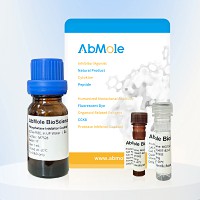All AbMole products are for research use only, cannot be used for human consumption.

Glypromate acetate is a neuroactive peptide with a potent action on acetylcholine release. Glypromate acetate is a weak NMDA receptor agonist binds to N-methyl-D-aspartate (NMDA) receptor with an IC50 value of 14.7 μM.
Glypromate (0-100 μM) potentiates the potassium evoked release of both acetylcholine and dopamine, increases K+ evoked acetylcholine release even at concentrations of 0.1 nM and significantly enhances evoked dopamine release.
In vivo, Glypromate (300 mg; i.p. once per day; on day 0, 6 and 12) shows an in vivo effect protecting the temporal cortical somatostatinergic system from Abeta insult. Glypromate acetate can be used for the research of neuroprotection.
| Molecular Weight | 361.35 |
| Formula | C14H23N3O8 |
| CAS Number | 32302-76-4 (free base) |
| Solubility (25°C) | Water 1 mg/mL DMSO 3 mg/mL |
| Storage | -20°C, dry, sealed |
| Related NMDA Products |
|---|
| GluN1 (356-385)
GluN1 (356-385) is an antigenic peptide against N-methyl-D-aspartate receptor (NMDAR) encephalitis. GluN1 (356-385) has the effect of reducing the density of surface NMDAR clusters in hippocampal neurons. |
| Radiprodil (RGH-896)
Radiprodil (also known as RGH-896) is an orally active and selective NMDA receptors antagonist which was evaluated as potential treatment of neuropathic pain associated with diabetic peripheral neuropathy (DPNP). |
| Trans-crocetin
Trans-crocetin (Croceic Acid) is a blood-brain barrier-permeable NMDA receptor antagonist with high affinity, extracted from saffron (Crocus sativus L.). *The compound is unstable in solutions, freshly prepared is recommended |
| L-Glutamic acid monosodium salt hydrate
L-Glutamic acid monosodium salt hydrate is also a Kainate receptor, NMDA receptor and quisqualate receptor agonist; an excitatory amino acid neurotransmitter. |
| Arcaine sulfate salt
Potent antagonist at the polyamine site of the NMDA glutamate receptor. |
All AbMole products are for research use only, cannot be used for human consumption or veterinary use. We do not provide products or services to individuals. Please comply with the intended use and do not use AbMole products for any other purpose.


Products are for research use only. Not for human use. We do not sell to patients.
© Copyright 2010-2024 AbMole BioScience. All Rights Reserved.
